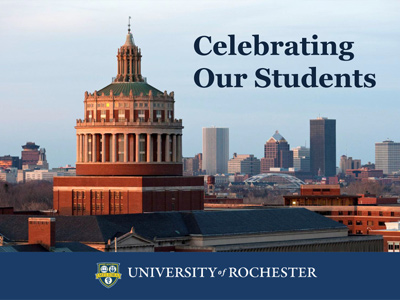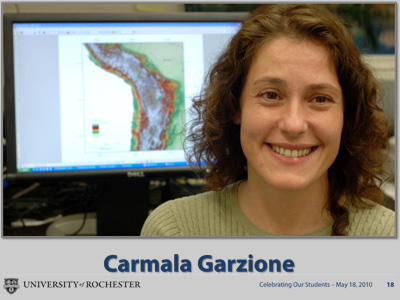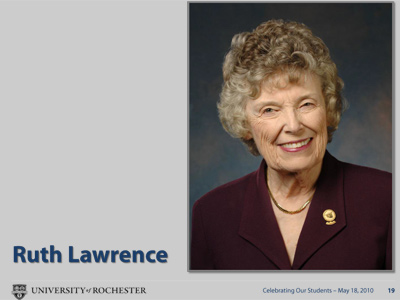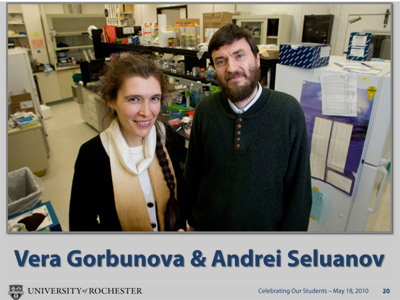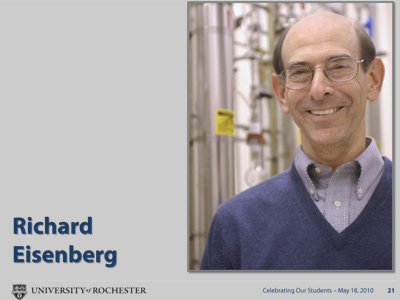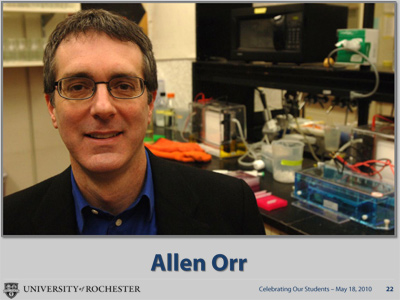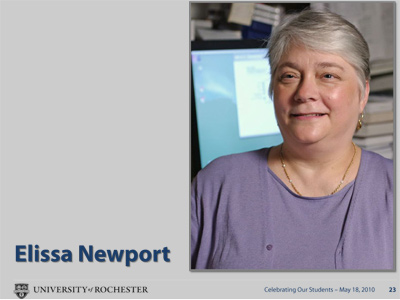CELEBRATING OUR STUDENTS
MAY 18, 2010
JOEL SELIGMAN
(To view the slides while reading the speech below, place your cursor over each “SLIDE” link.)
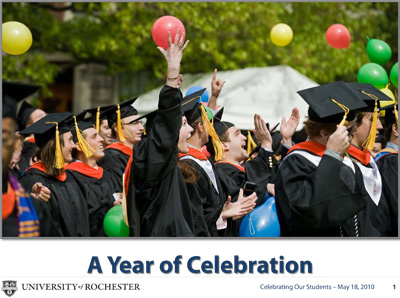
During the past year we have had much to celebrate.
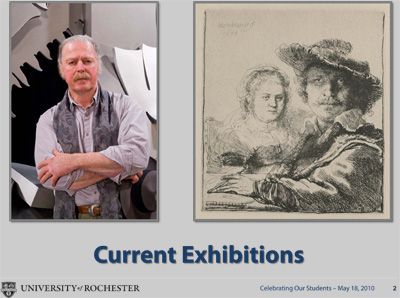
Today it is a particular pleasure to welcome you to the University of Rochester’s Memorial Art Gallery which has two magnificent current exhibitions; one featuring a selection of Rochestarian Albert Paley’s sculptures and drawings and the other showcasing 34 of Rembrandt’s rare master etchings from the collection of Tobia and Dr. Morton Mower. The MAG for close to 100 years has played a vital role in the Rochester community linking the University to our community.

In October 2009, we dedicated the Edmund A. Hajim School of Engineering and Applied Sciences in a ceremony that featured an address by
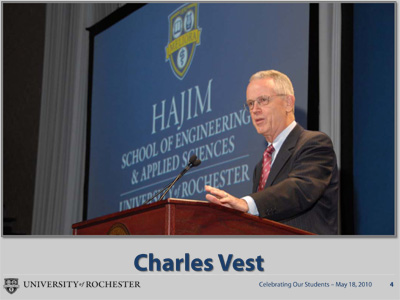
Charles Vest, MIT President Emeritus and current President of the National Academy of Engineering. Our Meliora Weekend featured a keynote address by our graduate
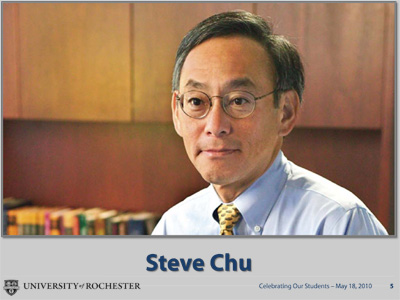
Steve Chu, Secretary of Energy and Nobel Laureate, and
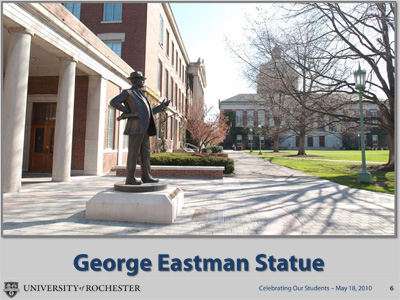
the dedication of the George Eastman statue in our central quadrangle.

On October 8th, we opened the renovated Kodak Hall at Eastman Theatre with a gala, sold-out performance by the Rochester Philharmonic Orchestra featuring Eastman School of Music Dean Doug Lowry’s original composition, Geo, in honor of Eastman.
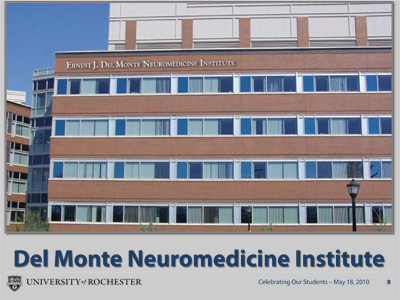
In December 2009, we dedicated the new Del Monte Neuromedicine Institute, supported by the second largest contribution in the Medical Center’s history from Ernie and Thelma Del Monte.
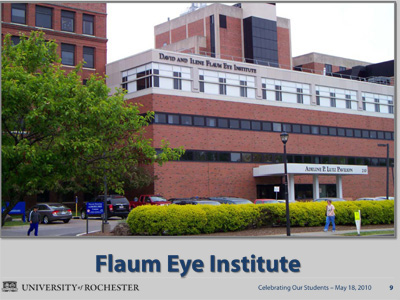
In December, we dedicated the David and Ilene Flaum Eye Institute, with its Adeline P. Lutz Pavilion named in honor of Adeline Lutz’s $6 million commitment to the Institute.
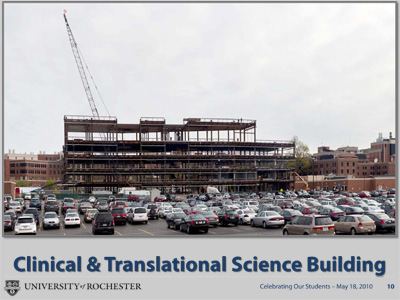
Earlier in June 2009, we broke ground for the Clinical and Translational Science Building, which is scheduled to be completed in the first half of 2011.
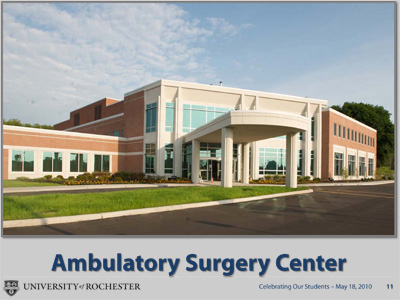
In July 2009, we dedicated a new 80,000 square foot Ambulatory Surgery Center, which added 10 new operating rooms to Strong Memorial Hospital’s 33 operating rooms.

In September 2009, we celebrated the expansion and renovation of the Wolk Emergency Department at Highland Hospital.
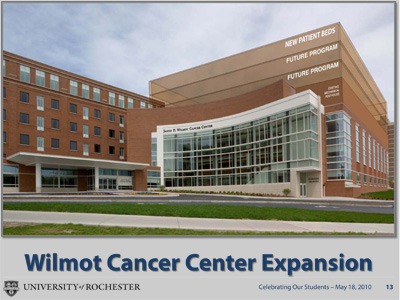
In October, the Board of Trustees approved resolutions to initiate a three-floor addition to the James P. Wilmot Cancer Center that will add 45 much-needed beds and will be the first step in a process that will lead to the construction of a new hospital tower to modernize Strong Memorial Hospital.
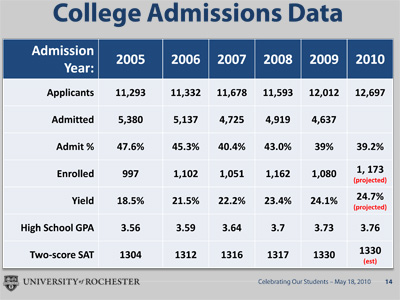
Undergraduate applications this year broke another record, rising to 12,697 for next year’s class.
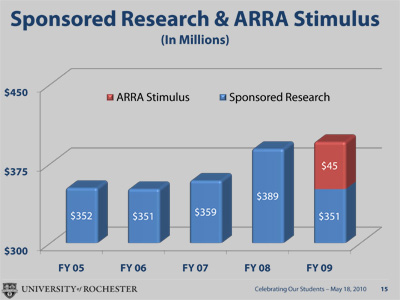
University research scientists continued to report extraordinary results. We finished the 2009 federal fiscal year with our aggregate government and private sponsored research funding equaling $351 million with an additional $45 million funds being received from the American Recovery and Reinvestment Act stimulus funding through March 2010.
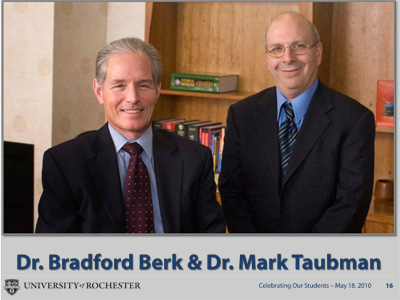
For me, the highlight of the past academic year was the return of Brad Berk as Chief Executive Officer of the Medical Center on March 1, 2010, some nine months after he experienced a severe spinal cord injury. His return marked a remarkable story of determination and courage. On March 1, 2010, Mark Taubman began his tenure as Dean of the School of Medicine and Dentistry, after exceptional service as Acting Chief Executive Officer during Brad’s rehabilitation.
This also was a year of stellar faculty achievements:
In September 2009, Professor of Mechanical Engineering Riccardo Betti won the prestigious Edward Teller Award for his fusion research.
In November 2009, Associate Professor of Earth and Environmental Sciences Carmala Garzione received the 2009 New York Academy of Sciences Blavatnik Award for her research that has helped redefine geologists’ understanding of the rate at which mountain ranges form.
Ruth Lawrence, professor of Pediatrics and Obstetrics and Gynecology, was awarded the 2009 Martha May Eliot Award by the American Public Health Association for her tireless efforts to improve women’s and children’s health.
Biology professors Vera Gorbunova and Andrei Seluanov won the Cozzarelli Prize for their pioneering research in the causes of cancer-resistance in naked mole rats.
In recognition of his outstanding scientific career, Richard Eisenberg, the Tracy H. Harris Professor of Chemistry, was elected to the National Academy of Sciences and the American Academy of Arts and Sciences – both in one year, which is amazing.
Allen Orr, who last year won the Darwin-Wallace award for his work on speciation, this year was elected to the American Academy of Arts and Sciences.
George Eastman Professor Elissa Newport in Brain and Cognitive Sciences and Linguistics was elected to the American Philosophical Society. Elissa has done path-breaking work in cognitive sciences and psycholinguistics.
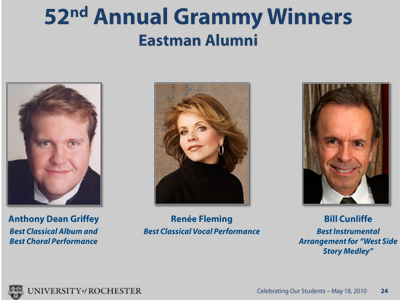
In all, Eastman faculty and alumni received 10 Grammy nominations this year, and three alumni won Grammies: Anthony Dean Griffey for Best Classical Album and Best Choral Performance; Renée Fleming for Best Classical Vocal Performance; and Bill Cunliffe for Best Instrumental Arrangement for a revival of West Side Story.
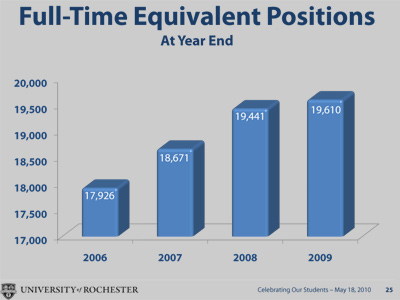
The University has become an economic bulwark of the Rochester community. As of December 31, 2009, the University was the leading employer in the Rochester region with 19,610 full-time equivalent jobs, having added 167 new jobs during a recession year.
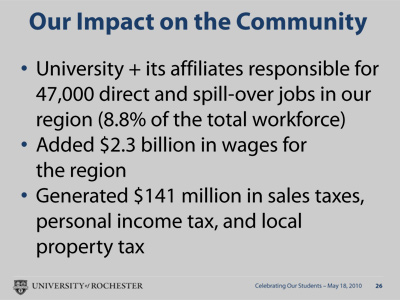
When combined with its affiliates, the University of Rochester was responsible for approximately 47,000 direct and spill-over jobs in our region or approximately 8.8 percent of the total workforce; added $2.3 billion in wages for the region; and generated $141 million in sales taxes, personal income tax, and local property tax to the Rochester region and New York State, according to the Center for Governmental Research.
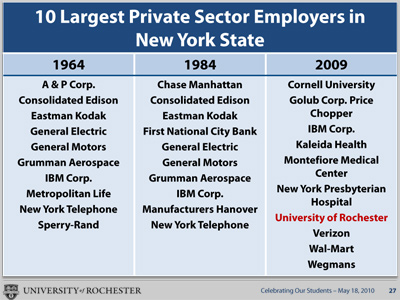
There is an important story underlying these data. Over the past several decades, our state has evolved increasingly to a knowledge-based economy in which by 2009 five of the largest ten employers in New York either are universities, health centers or both. Today the University of Rochester is the sixth largest employer in the state. A key to the University’s growth has been our focus on innovation. During the past eight years, we have been ranked as one of the top ten universities in the country in terms of patent royalties – an extraordinary tribute to the talents of our faculty.
I am now completing my fifth year at the University. I have truly enjoyed joining a fabulous community and participating in the leadership of a University that continues to make substantial progress. Tonight I want to focus on what for me has been one of the greatest pleasures of the last five years – our amazing students.
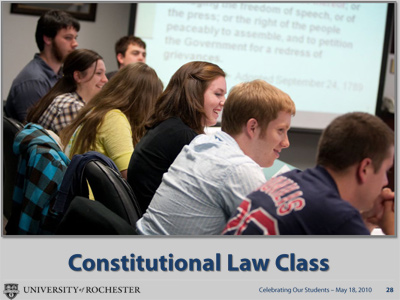
Nothing for me is more fun than teaching. For three of the last four years I have taught an undergraduate class in the United States Supreme Court and Constitutional Law, sometimes called “Greatest Hits of the Supremes.” I particularly enjoy participating in a seminar that begins with students learning what a case is and
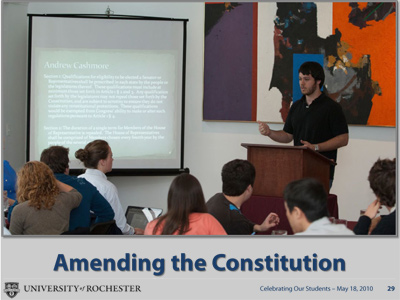
concludes with students proposing, debating and voting upon amendments to the Constitution.
I teach about 20 undergraduates in this seminar. There are more than 9,900 students at our University. All are fascinating. Let me tell you some of their stories.
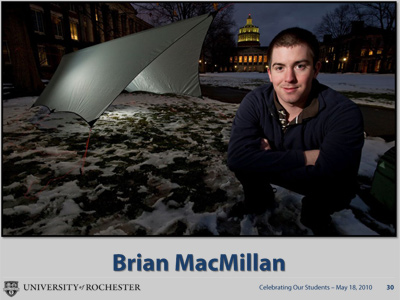
Not many students these days, let alone a young man, arrive on campus with a sewing machine. But that is exactly what senior Brian MacMillin did his freshman year. In the years that followed, you could have run into him sewing tarps, often into the late night hours, in the basement of the Hopeman Engineering Building or one of the dining halls on campus. Now, at age 22, the mechanical engineering major is the president and owner of a profitable company, Outdoor Equipment Supplier. This young entrepreneur also works on the assembly line, as the company’s entire labor force.
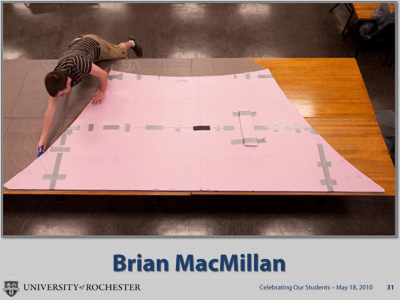
Brian designs and manufactures ultra-lightweight, durable camping tarps for backpackers who don’t want to carry a full tent with them, but need protection from rain, wind, and snow. Brian has woven his business interests into his mechanical engineering education at the Hajim School.
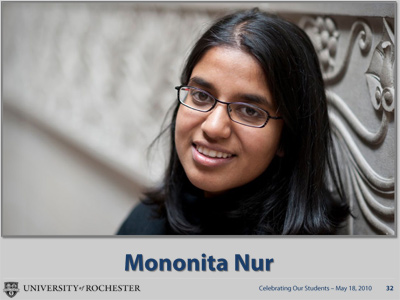
Mononita Nur, a freshman biomedical engineering major, lived in two foreign countries before coming to the University of Rochester. She was born in Bangladesh and speaks fluent Bengali. She moved to England as a child, and then to Ohio where, by the time she finished high school, she was already taking university courses at Miami University of Ohio. She is a Hajim Scholar, and she’s interested in the field of biomechanics because it allows her to apply a subject that she loves, physics, to the design of devices like prosthetics and joint replacements that have the power to improve peoples’ lives in a tangible way. Upon entering the University, she took up fencing and is now the assistant quartermaster of the fencing club and a competing member.
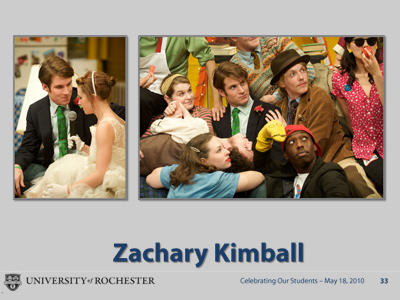
Zachary Kimball is an award-winning actor on our campus, where he won the 2009 Charles I. Keelan Memorial Award in Theatre for outstanding acting and scholarship. Zach is not a theater major, but his interest led him to our International Theatre Program. He has performed in several productions: King Lear, The Lower Depths, Curse of the Starving Class, You Can’t Take It with You, and The Hairy Dutchman. He also redesigned the website for Todd Theatre after creating and implementing the interface from scratch. In typical Rochester fashion, Zach graduated this spring with degrees in economics and political science and headed to law school at Harvard.
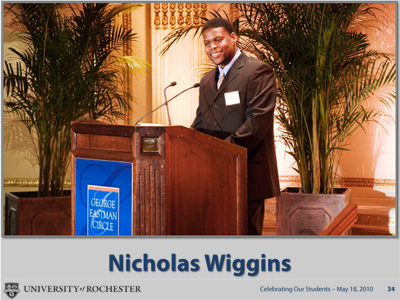
Junior Nicholas Wiggins was the star of our recent George Eastman Circle dinner in New York City. He’s an economics major in the College, a vocal performance major studying opera at the Eastman School, and for his first two years at Rochester was a defensive lineman for our football team. Nick is also
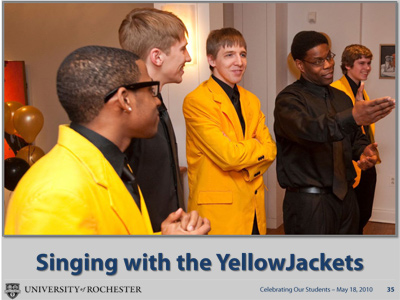
treasurer of the YellowJackets, our beloved student a cappella ensemble. Nick describes the freedom he’s found at Rochester to explore such diverse interests “empowering.”
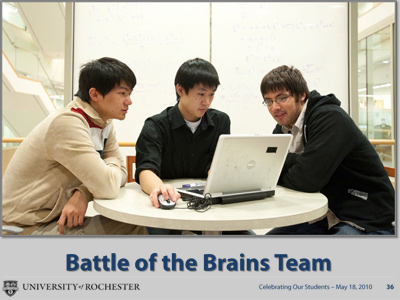
In November, the University of Rochester became the first school in six years to beat MIT in the regional finals of the oldest, largest, and most prestigious computer programming competition in the world, popularly dubbed the “Battle of the Brains.” Ian Christopher, Dennis Huo, and Xiaoqing Tang and their advisor Daniel Stefankovic won the Northeastern North America region in the Association of Computing Machinery’s International Collegiate Programming Contest. This winter, the students flew to Harbin, China, for the international finals. It was the first time a team from the University made it to this big event, where the team took home an honorable mention.
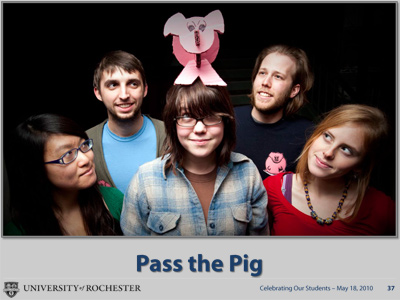
The next time someone says, “Pass the Pig,” to you, keep in mind that the admonition is intended to help your savings account grow. “Pass the Pig” was the slogan created by a team of University students that was one of only two teams from the United States and 22 teams worldwide to be named global winners in the 2009 Stanford Global Innovations Tournament. The five-member team included undergraduates Jennifer Burger, Elaina Stover, Eric Wisch, and Dan (Eva) Xie, and graduate student Justin Peczkowski. They were one of nearly 1,000 teams that were asked to come up with creative ideas on how to “make saving money fun,” and then convey those ideas through short videos posted to YouTube.
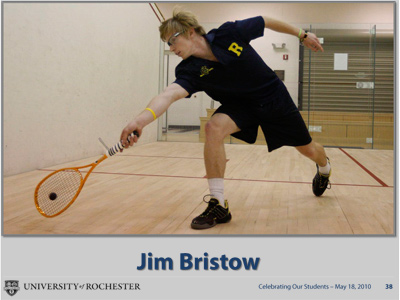
Senior Jim Bristow is an example of the scholar-athlete we celebrate at Rochester. The senior from Devon, England, is the first Rochester squash player to be named an All-American four years in a row. And he’s the only senior squash player in the country this year to earn the honor each year of his college career. Jim represents one of the extraordinary aspects of Rochester’s squash program, which this winter finished in the national championships.
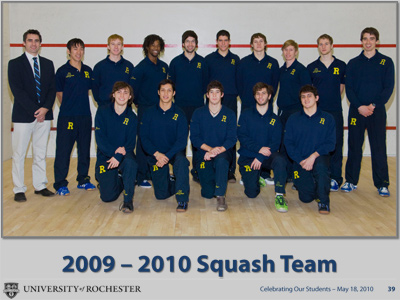
It’s the second year in a row that Rochester finished among the top four teams in the country. Drawing on players from all over the globe, the current Yellowjacket squash team includes students from England, Finland, Japan, Switzerland, Colombia, and Mexico, as well as the United States. The Rochester squash team, coached by Martin Heath—a native of Scotland, by the way—have put Rochester’s name in the upper echelons of the sport, along with such schools as Harvard, Yale, and Trinity College.
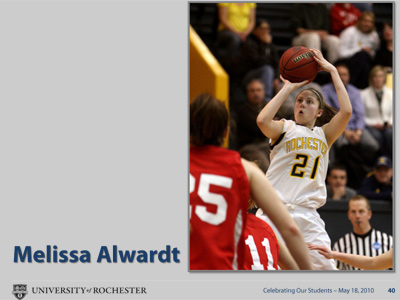
Melissa Alwardt helped lead the Rochester women’s basketball team to the NCAA Division III Final Four. On the court, Melissa was the team’s leading scorer who averaged nearly 13 points a game, shot 42 percent beyond the arc, and was named the MVP of two tournaments. Off the court, Melissa is a health and society major with plans to pursue a career in health care. This season she led a team that turned out to be the Cinderella story of the national tournament. The only unranked team in the country to reach the Final Four, the Yellowjacket women’s basketball team defeated some of the top teams in the country on their way to a fourth-place finish.
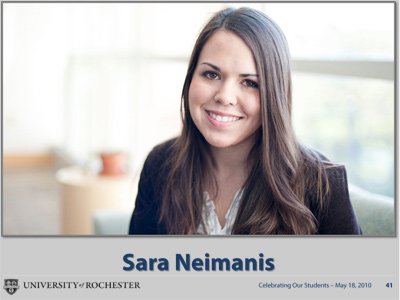
Sara Neimanis was in her junior year as biomedical engineering major getting ready for medical school when she was captivated by an idea: Why does music evoke such strong emotions in people? And how does the brain interpret music and language? At many universities, that would have been the end of the matter: In order to ensure that students finish their degrees and graduate, many colleges offer students little flexibility to follow their natural curiosity about an intriguing question. But not at Rochester. For 21 years, we have had a program known as Take Five that empowers students like Sara to spend a tuition-free year after graduation exploring courses they were unable to take while working towards a degree in Arts, Sciences, and Engineering or at the Eastman School. After finishing her degree in biomedical engineering, Sara spent the past year combining courses in linguistics and brain and cognitive sciences along with courses at the Eastman School to delve deeply into the questions about music, language, and cognition that she notes will be of enormous value to her as a scholar and scientist.
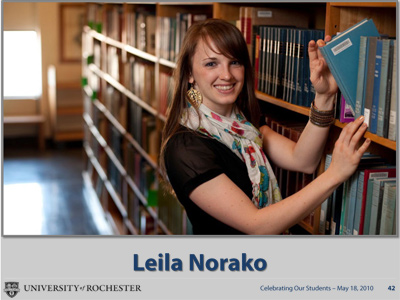
Our College of Arts, Sciences and Engineering is not limited to undergraduates but also includes extraordinary graduate students. Leila Norako, a PhD candidate at Rochester and native of Hawaii, has a BA in English literature and Medieval and Renaissance studies from the College of William and Mary. After college, she taught high school for a year before deciding to continue her scholarship at Rochester. Kate is interested in the Crusades and their influence on literature. She has presented papers at several of the field’s top conferences on the topic. She’s also worked on a number of Crusades-related projects while working in Robbins Library, including the creation of the Crusades Project, a forthcoming electronic resource attached to the Camelot Project and centering on the representations of the crusades in Western European and American literature. Kate also went to Iceland to study Old Icelandic so that she could prepare an edition of an Icelandic saga that describes a Viking participating in the Crusades. Magnussona Saga: A Critical Edition will be published by the Middle English Texts Series, which publishes some non-English texts of particular relevance to England or to themes in Middle English literature.
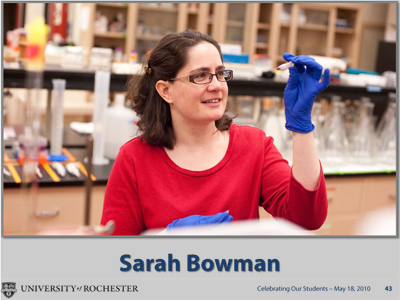
Sarah Bowman, a fifth-year graduate student who was an English major as an undergraduate, decided to return to school and study chemistry after discovering that science is her true calling. Sarah is now part of a research team studying how proteins transport energy throughout the body. These proteins are of intense interest because they are involved in all metabolism, from respiration to aging. In particular, Sarah has been developing new nuclear magnetic resonance (NMR) probes to aid in these investigations. Sarah was selected to be a student participant at the 59th meeting of Nobel laureates and young researchers in Lindau, Germany. At that meeting, she was selected by the young researchers to be their representative to give the closing statement. The recipient of the Edward Peck Curtis Teaching Award, Sarah hopes to pursue a University teaching career.
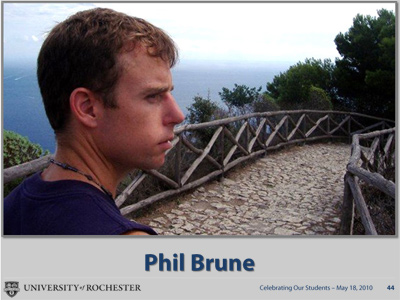
Phil Brune conducts research in archaeology, engineering, and history. His work involves testing the mortar used in ancient Rome in order to explore how the ancient Roman concrete buildings work as structures. Although he has a small collection of 2,000-year-old concrete, he’s re-fabricating concrete using the original Roman recipe. The work requires him to figure out some of the original recipes’ “missing ingredients,” namely how much water is necessary. Phil jokes that although he hasn’t tested it yet, he thinks that it’s high quality mortar. He notes with humor that if all his research doesn’t pan out, he can always become a mason. He also teaches both a freshman writing and a graduate engineering course. He tutored for the Liberty Partnerships Program, where he helped at-risk high school students with math, chemistry, reading comprehension, and history. Trained in classical ballet, he also has two internationally certified sailing licenses and has raced several times out of the Genesee Yacht Club.
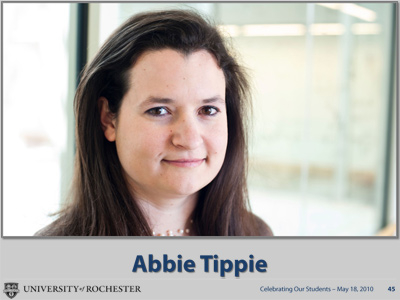
Abbie Tippie, a fourth-year PhD student, earned first place for her team’s plan for a business called CustomEyes that would develop contact lenses that correct higher order aberrations. She and her team won first place in the Mark Ain Business Model Competition, administered through the Simon School. Actively involved serving the community, both in Rochester and abroad. Abbie was chosen as one of 10 graduate students from across the country to participate in a National Science Foundation winter school on nanotechnology in Mumbai, India, and surrounding rural communities last December.

Our Eastman School of Music is home to undergraduate and graduate students. Catherine Branch is a graduate student who has never let the experience of having cerebral palsy slow her down. In sixth grade she wanted to play the cello. The instrument was too large to handle without falling over, so her parents bought her a flute. After graduating from Rice University and receiving a grant, Catherine commissioned new works and embarked on a yearlong world tour. She performed and taught, using music and her experience to spur conversations on difference, disability, and diversity. At Eastman, she’s a master’s degree student who, in addition to taking music and performance courses, is enrolled in the Arts Leadership Program. Catherine is continuing to build audience connections through a concert series she’s creating called “Music of Difference.” For the first performance, she’s putting together a multimedia event, with other Eastman musicians and an artist-designer, which will be presented in Rochester in May.
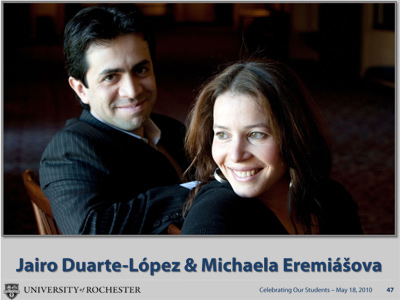
Michaela Eremiášova and Jairo Duarte-López are award-winning composers and PhD candidates at Eastman. Each has a background collaborating with filmmakers, and the husband-and-wife couple resurrected a film-scoring course at Eastman. They consulted with Emmy Award-winning composer and Eastman alumnus Jeff Beal on their new course, offering it for the first time in the 2008-09 academic year. In 2009, their chamber work Car Crash Opera was one of only eight out of 80 submissions to be showcased in New York City Opera’s acclaimed VOX Festival. Both received a 2009-10 ASCAPlus Award, a special award that recognizes early- and mid-career composers for their body of work.
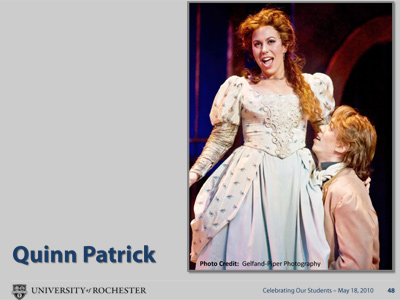
As a doctoral student of voice at Eastman, Quinn Patrick juggles a busy professional performance and teaching schedule. She’s a mezzo-soprano who has performed with such companies as the Glimmerglass Opera, Mercury Opera Rochester, and Jacksonville Lyric Opera; in concert with the Buffalo Philharmonic, Syracuse Symphony, the Jacksonville Symphony, the Boulder Philharmonic, and other orchestras and ensembles; and has appeared in Lincoln Center and Carnegie Hall. As a teacher, Quinn gives individual voice lessons to 19 students from both Eastman and the River Campus every week. In addition, she’s a lecturer of voice at Nazareth College. As if that kind of schedule wasn’t enough, Quinn is a triathlete who has completed two marathons, three half-marathons, two half-ironman competitions, sprint distance triathlons, and several 5k and 10k runs. This fall, Quinn will be teaching in a tenure-track position as assistant professor of voice at Texas Tech University.
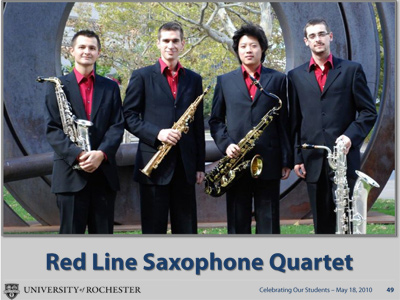
The Red Line Saxophone Quartet—which includes Eastman students (seniors) Brandon Kies, Gai Qun, Quinn Lewis, and doctoral student Douglas O’Connor — stunningly has won six national chamber music competitions since the four began playing together in spring 2008, including First Prize in the 2010 North American Sax Alliance and Plowman Chamber competitions,
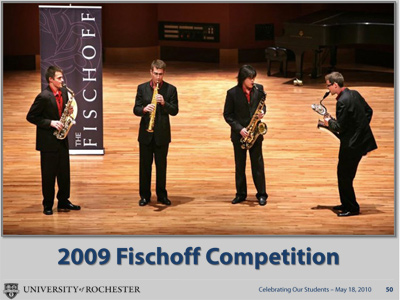
the 2009 Fischoff and MTNA National Chamber Music Competitions, and just last month Grand Prize in the Coleman Chamber Music Competition. Red Line memorably made their orchestral debut alongside heralded saxophonist Branford Marsalis and the Alexandria Symphony Orchestra. When Marsalis appeared in Rochester last fall in a benefit concert, he was quoted in the Democrat and Chronicle as saying about Red Line, “Man, those guys can play.”
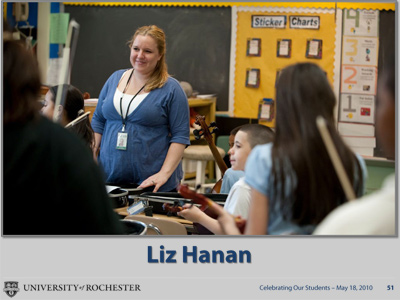
Eastman master’s degree student and double bass player Liz Hanan is bringing the joys of stringed music to a new generation of students in Rochester. For the past dozen years, the Eastman School has had a special relationship with the Enrico Fermi School No. 17 in the Rochester City School District. Eastman students go to the school to mentor and coach the school’s string students during their practice time. Starting as a music teacher in the school when she received her bachelor’s degree in 2006, Liz now runs the string program. Under her leadership, the program has grown from about 20 string players in grades 3 through 6 who were involved in the program to more than 70 students. Liz has been a steady presence at the school for four years, leading music and helping develop routines for all students in the school.
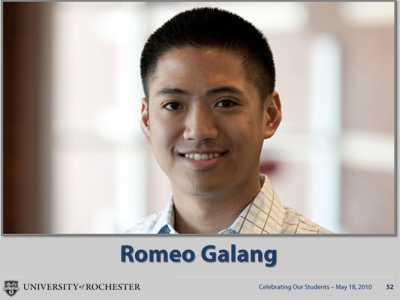
We are proud that our outstanding students are also in our professional schools. Romeo Galang, for example, graduated this year (2010) from the School of Medicine and Dentistry and soon will be a resident in obstetrics and gynecology. A 2003 graduate of the University with a bachelor’s degree in health and society, he also earned a master’s in public health at Tulane University in New Orleans, where he grew up.
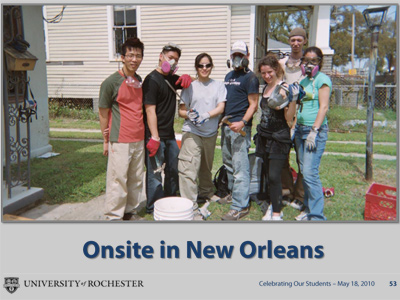
Romeo was a volunteer in the Lower Ninth Ward after Hurricane Katrina, working with a team that recovered personal items from flooded homes and conducted community health outreach.
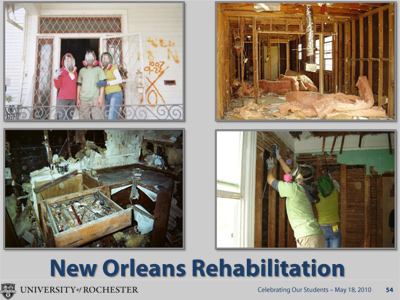
Throughout his four years at the School of Medicine and Dentistry, Romeo volunteered with the UR Well program at the St. Joseph’s Community Center in Rochester, which provides free health care to the poor and uninsured.
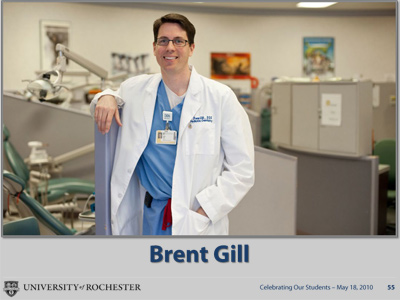
Brent Gill, who has worked as a professional audiologist since 1997, decided to change careers and came to the Eastman Institute for Oral Health to study pediatric dentistry. Brent is the father of six children – five boys and one girl ranging in age from 7 months to 14 years. Brent believes his role as a parent will make him a better dentist. Having six kids at home, all in different stages of development is like overseeing a “kids laboratory.” This allows him to speak the language of worried parents who, in Brent’s words, “want to be informed and reassured that things will be okay.” Brent views dentistry as a profession that will allow him to work closely with patients through the entire process – from diagnosis to recovery – a prospect that he finds very rewarding.
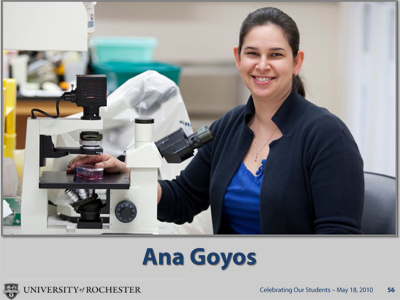
In the spring of 2002, when she was a student at Florida International University in Miami, Ana Goyos attended a series of lectures given there by Nicholas Cohen, then a professor of microbiology and immunology at the School of Medicine and Dentistry. Cohen, who received his doctorate in 1966 from Rochester and is now professor emeritus, focused his research and his talks on evolutionary and developmental immunology. The encounter started Goyos, the daughter of political refugees who emigrated from Cuba, on the road to Rochester and a PhD in immunology. Ana investigates “recognition events — how a body can or can’t recognize potential cancer cells and what cells and molecules mediate the recognition.” This interest dates to the death of her mother in 1996 from Hodgkin’s Lymphoma. This spring, Ana accepted a postdoctoral position in a lab at Stanford University, where she will investigate the biology, genetics, and evolution of Major Histocompatibility Complex (MHC) class I molecules, Natural Killer cell receptors, and other immune system molecules.
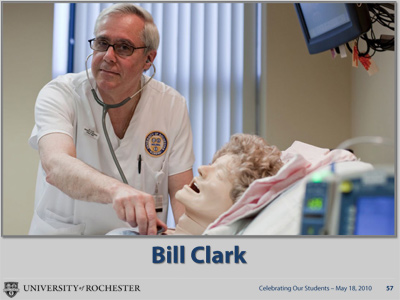
Our commitment to professional education is also evident in our School of Nursing and its remarkable accelerated degree program, often used by our students to pursue a second career. For more than 30 years, Bill Clark was a distinguished educator and school administrator. After retiring as an assistant school superintendent and relocating from Long Island to Rochester to be near family, he decided his working years weren’t quite behind him. He began our accelerated nursing program in May 2009. Bill is also an online graduate professor for Stony Brook University and serves on a Diocesan Committee preparing couples for marriage, even learning sign language to help prepare couples who are part of the deaf community. Recently, he and his wife have been volunteering at Strong Memorial Hospital on Sundays, bringing communion to those patients unable to attend Mass. Bill graduated May 14 and at 62 he looks forwarding to starting his nursing career as a hospice nurse.
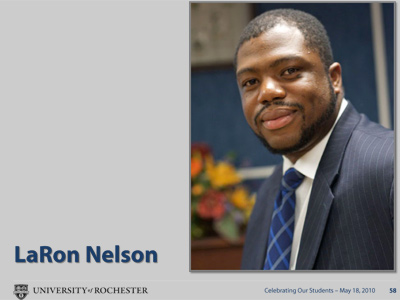
When LaRon Nelson lost his grandfather and then a friend to HIV, many around him accepted their deaths as a part of life, but LaRon could not. He became determined to effect change. He enrolled in what was then the School of Nursing’s traditional baccalaureate program and completed the master’s portion of the school’s MS/PhD program in 2004. Last July, he defended his dissertation and on May 15, he became the first African-American man to receive a PhD from the nursing school. Never forgetting what inspired him to enter nursing, as a student LaRon worked on NIH–funded projects involving HIV prevention interventions with high-risk young urban and minority women. He also practiced as a nurse practitioner in a teen clinic that he and a multidisciplinary team helped re-establish in an inner city neighborhood. He was a University Provost’s Fellow, a Leadership Education in Adolescent Health Fellow, and both an Individual and Institutional National Research Service Award recipient while at the School of Nursing. LaRon hopes to educate a new generation of nurses, continue his research, and contribute at the public health policy level in order to positively affect peoples’ lives.
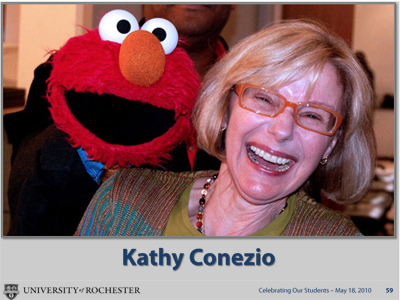
Our Warner School of Education also is making a difference in our community. Kathy Conezio, a doctoral student at the Warner School, serves as the head science curriculum advisor for Sesame Workshop, the nonprofit educational organization behind Sesame Street. As the ever-popular children’s show celebrated its 40th anniversary, it took on a new focus: teaching young children about science through the world around them. Conezio, a classroom teacher and preschool curriculum specialist, spends most of her time working closely with the team’s writers and producers to review Sesame Street scripts, evaluating science content for accuracy and making sure the presentation is developmentally appropriate for the show’s audience.
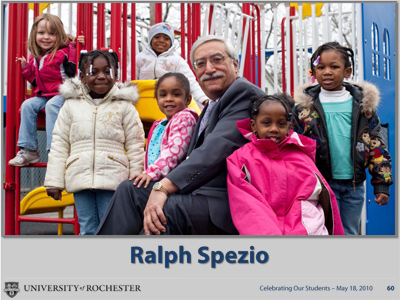
Child advocate Ralph Spezio, who is pursuing his doctoral degree in educational administration while working full-time in the Medical Center’s Department of Community and Preventive Medicine, first discovered in 1999 that something was wrong with the health of the children in the Rochester elementary school where he was principal. Since 1999, when Ralph learned that the three- to five-year olds in the school where he was principal had blood-lead levels 10 times the national average, he has worked to treat and prevent child lead poisoning, and he is now doing his dissertation research on the impact existing computer software has on the reading scores of lead-poisoned children. He was a co-founder of and currently helps lead the community-based Coalition to Prevent Lead Poisoning, which received the 2009 Environmental Justice Achievement Award from the Environmental Protection Agency.
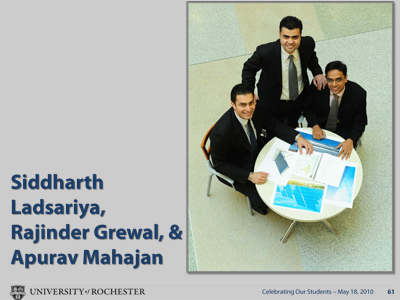
Within a few months, Simon School finance MBA students Siddharth Ladsariya, Rajinder Grewal, and Apurav Mahajan will have created a solar power plant in their home country of India.

The three students arrived at the Simon School with backgrounds in banking and investment management, and they embraced the culture of entrepreneurism at Simon. Along with plowing through Simon’s rigorous MBA program, the trio have completed a business plan for the solar power plant, secured funding for it, and have found the vendors they need to make the project a reality. Currently, the project is pending government approvals. Siddarth, Rajinder, and Apurav are betting that solar power will be key in meeting India’s growing energy needs.
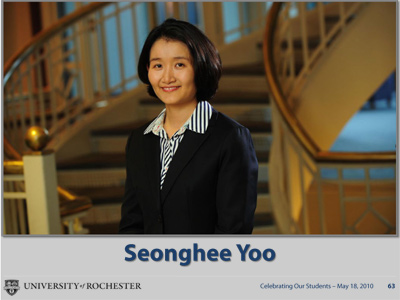
Seonghee Yoo ’10S (MBA) is breaking new paths for her employer, Korea Electric Power Corporation in Seoul, Korea. An assistant manager in the company’s treasury department, Seonghee is a certified public accountant who oversees financial statements representing $30 billion in sales. She’s earned the company’s CEO award for her work to bring innovative training programs to the company. She is the first woman whom Korea Electric Power has ever sponsored to study for an MBA, and she is earning her degree at our Simon School. Not many years ago—and in most programs—she would have been outnumbered substantially by male classmates. But that’s not the case at Simon, thanks to a leadership effort to bring more women into business education earlier in their careers. At Simon, 30 percent of our full-time student body is female; and in the executive MBA program— Seonghee’s program—37 percent of our class is female. Both are well above national averages. In addition, Simon has more international students than any other MBA program in the top tier – 50 percent versus an average of 35 percent. Seonghee has also been part of an international stage in another sense. She performed Korean traditional dancing for the opening ceremonies of the 1988 Olympic Games in Seoul.
On April 8th, we had our first ever all-University celebration of our scholarship students. This was a very special occasion in which we saluted the wonderful supporters of our great students and focused on the insoluble bonds that join generations of Rochesterians.
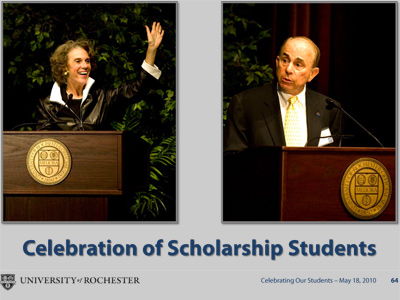
Our chair Ed Hajim and Trustee Gwen Greene began the evening by recalling how much scholarship support had meant to them in attending Rochester and how their chance to study here had been the foundation of their extraordinarily successful lives. Ed has now provided support for more than 100 scholarship recipients at the University of Rochester and elsewhere.
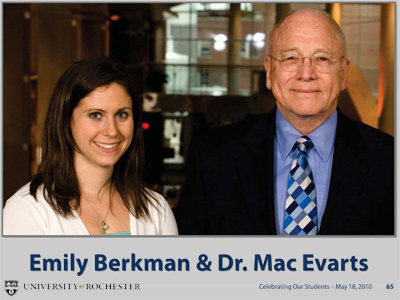
Emily Berkman, a medical student, is the recipient of the Mac Evarts scholarship and sat with Mac at the dinner. When she first met Mac, he was Chief Executive Officer at the Medical Center and long renowned as one of this nation’s most innovative orthopedic surgeons. Emily recalled meeting Dr. Evarts during an autopsy when he exclaimed with delight that the decedent had had a knee replacement. Emily has decided to go into pediatrics when she graduates, a decision she says was inspired by her Evarts scholarship. Next year, she plans to travel to Vietnam to assist with cleft lip and palate surgeries for children in need.
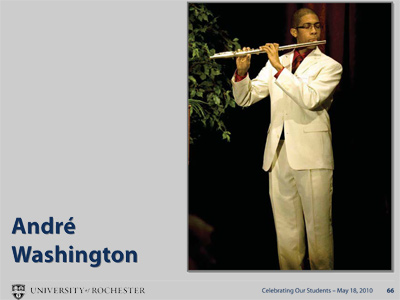
A highlight of the scholarship dinner was hearing André Washington speak and perform on the flute. André, who just graduated from Eastman a few days ago, spoke movingly of his love for music and how it has transformed his life. When he was 15 André heard a recording of Tchaikovsky’s Fourth Symphony and became determined to learn to play the flute. Initially he was self-taught. Soon his astonishing talent was recognized, first by the Merit School of Music in Chicago and in 2006 by Eastman. In 2009 he was chosen to be principal flutist of the Oberlin in Italy opera festival and next year he will study at the École Normale de Musicique de Paris as a Fulbright Scholar. This ultimately might not have been possible but for the support of alumni and friends that provided the means for him to study at Eastman on scholarship.
For me there was one other highlight that I cherish.
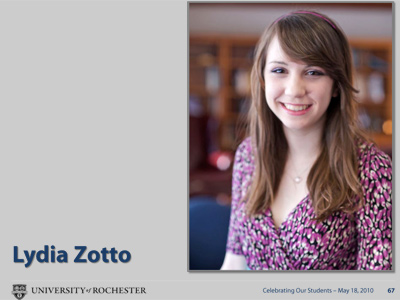
Before dinner during the reception I met Lydia Zotto, who graduated a few days ago as a harp student at Eastman. Since her name tag identified her as “10E” (meaning Eastman graduate this year), I asked her what she planned to do after she graduated. I was aware of the likely choices – such as perform, teach, or go to graduate school. Lydia surprised me by explaining that she intended to earn an MBA, then an MD degree, and go into hospital administration. I knew our students were talented and multifaceted, but this was impressive even by Rochester standards. Standing next to Lydia was another student with a name tag labeled “10E.” Somewhat in awe of Lydia, I asked this student if she also intended to pursue a career in health care administration. The student visibly stiffened. “Certainly not,” she explained. “I am going to law school.”
I hope you now understand why our students are among the most wonderful aspect of my job.
